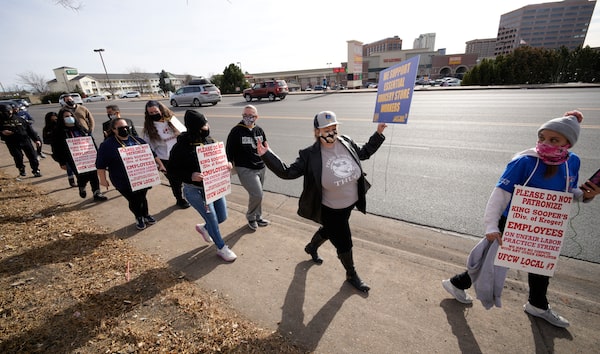
Grocery store workers cheer as they picket outside a King Soopers store after rejecting the latest contract offer from the chain that is owned by Kroger, Co., on Jan. 13, 2022, in east Denver.David Zalubowski/The Associated Press
At the entrance to a King Soopers filling station a few days ago, a solitary picketer held up signs and tried to persuade drivers to gas up somewhere else.
“Go to Shell,” he mumbled, in a voice barely loud enough to be heard.
It was a low-volume act of protest, part of a nine-day strike by 8,500 workers at King Soopers grocery chain that ended Friday with a tentative agreement. Denver-headquartered King Soopers is owned by grocery giant The Kroger Co.
Recent history has not been kind to organized labour in the United States. On Thursday, the Bureau of Labor Statistics reported the latest data: a decrease in unionized workers in 2021, down to 10.3 per cent of the work force, a return to the historic lows of 2019. (In Canada, roughly 30 per cent of workers are unionized.)
At the outset of the pandemic, widespread non-union job losses caused a brief bump in the U.S. unionization rate. Last year, however, the public sector shed 191,000 union jobs, while a surge in hiring brought back large numbers of non-union workers.
But if that marked a return to what has become normal in the U.S., labour economists say changing economic conditions – with inflation running high and a “Great Resignation” that has seen millions of people ditch jobs – are tilting the balance of power in favour of workers. It’s a shift that stood in the background of the quick resolution of the strike this week by the King Soopers employees. Short strikes, researchers say, favour workers.
“I think we do have the power right now,” Frank Esposito, a King Soopers meat-cutter, said from the picket lines earlier this week, as he described colleagues living in cars or struggling to buy food on wages as low as US$12.45 an hour.
Whether that is true is being tested across the country, with union organizers losing a high-profile bid last year to unionize an Amazon warehouse in Alabama, while winning more modest efforts to unionize two Starbucks stores in the Buffalo area. Late last year, unionized workers at John Deere secured an immediate raise of 10 per cent, and an $8,500 signing bonus, after a month-long strike.
Starbucks workers vote to unionize at store in Buffalo
Teamsters to vote on division to unionize Amazon workers
The U.S. has entered into an economic environment that has historically offered unions fertile ground. December inflation hit 7 per cent, the fastest cost-of-living increase in nearly four decades.
“It’s well known that the biggest driver of momentum for unions comes from inflationary pressures,” said Rafael Gomez, director of the Centre for Industrial Relations and Human Resources at the University of Toronto.
Worker shortages have already created wage pressure across the U.S. Widespread supply-chain disruptions have diminished the reliability of overseas labour, further enhancing the standing of domestic workers.
“There’s so many forces that are just coalescing and combining now that seemingly are giving rise to a different playing field,” Prof. Gomez said.
“For years, capital was scarce and labour abundant,” he said. “Now, we have kind of the opposite.”
It calls to mind the 1970s, he said, one of the periods of greatest labour unrest in recent history. Inflation throughout that decade averaged 6.8 per cent. In 1970 alone, the U.S. Bureau of Labor Statistics counted 5,716 strikes.
In 2020, the bureau tallied eight major work stoppages, the third fewest since 1947.
Last year, the Labor Action Tracker run by Cornell University tracked 366 strikes of all sizes. The numbers are not directly comparable with those documented by the bureau, which includes only strikes with more than 1,000 workers.
But a Bloomberg strike database showed a considerable rise in job action last year.
None of this “necessarily means that we’re headed toward labour revolution,” said William Spriggs, a scholar at Howard University who is chief economist to the AFL-CIO.
For decades, governments in some parts of the United States have created employer-friendly policies that have eroded the influence of organized labour. A federal bill to modernize U.S. labour law, the Protecting the Right to Organize Act, has twice passed the House of Representatives, but failed on the Senate floor.
“The challenges are still immense,” Prof. Spriggs said.
“It is undoubtedly true that more people, I think, will seek to organize. But until we change the law, I think we’ll continue to have these kind of marginal victories.”
Organized labour has nonetheless achieved a level of public popularity unseen in years, with a Gallup poll last year showing 68 per cent approval of unions, the highest since the late 1960s.
None of that definitively signifies a return to labour strife.
In an inflationary environment, what companies “ought to be doing is pre-emptively improving the treatment of workers,” said Layna Mosley, a Princeton scholar who has studied the relationship between workers’ rights and global supply chains.
Indeed, private-sector non-farm earnings in the U.S. rose 4.7 per cent in December, compared with the previous year, although that increase was eclipsed by inflation.
In Colorado, the details of the King Soopers tentative agreement have not yet been made public, but the deal “ensures that our members will receive the respect, pay and protection they warrant,” United Food and Commercial Workers Local 7 president Kim Cordova said in a statement Friday. She had earlier promised an “industry-leading contract.”
“We are pleased that this agreement allows us to put more money in our associates’ paycheques and secures health care and pension plans,” King Soopers president Joe Kelley said.
Our Morning Update and Evening Update newsletters are written by Globe editors, giving you a concise summary of the day’s most important headlines. Sign up today.
 Nathan VanderKlippe
Nathan VanderKlippe